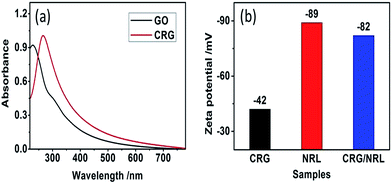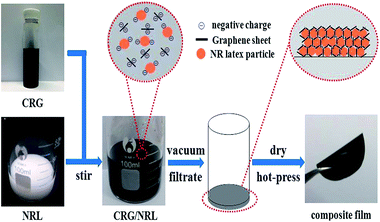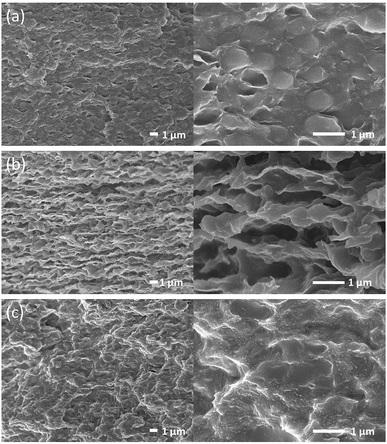Fabrication of natural rubber nanocomposites with high graphene contents via vacuum-assisted self-assembly†
Hongsheng Yang,
Ping Liu,
Tongping Zhang,
Yongxin Duan* and
Jianming Zhang*
Key Laboratory of Rubber-Plastics, Ministry of Education/Shandong Provincial Key Laboratory of Rubber-plastics, Qingdao University of Science & Technology, Qingdao City 266042, People's Republic of China. E-mail: dyx@qust.edu.cn; zjm@qust.edu.cn; Fax: +86 532 84022791; Tel: +86 532 84022604
First published on 4th June 2014
Abstract
High-nanofiller-content graphene/natural rubber nanocomposites with high electrical conductivity (up to 104 S m−1) and excellent mechanical properties (tensile strength, 48 MPa; modulus, 1.2 GPa) have been obtained via vacuum-assisted self-assembly for the first time.
Over the past decades, nanofillers, such as carbon black, silicon dioxide, layered silicates and carbon nanotubes, have been incorporated into polymer composites1 to improve not only their strength and anti-abrasion properties, but also their electrical conductivity and permeability resistance. In the field of composites, there has been never ending search for advanced nanofillers with unique physical or chemical properties, aiming to acquire high-performance materials for meeting the demands of critical applications. As a latest form of nanocarbon, graphene is undoubtedly a promising nanofiller for polymers, after carbon nanotubes, due to its naturally imparted excellent properties in modulus, tensile strength, and electrical conductivity.2
However, only a small fraction in the large body of literature on graphene/polymer composites focused on graphene-filled rubber,3–8 especially nonpolar species such as natural rubber (NR). Most recently reported methods for preparing graphene/NR nanocomposites can be divided into two classes: (i) solution treatment (latex mixing): graphene or graphene oxide (GO) dispersed in solvents is intermixed with NR latex (NRL) to form a homogeneous mixture, and then a latex coagulation or solution-casting method is employed.5–8 (ii) Mechanical mixing (conventional) methods: graphene powder is directly blended with a solid NR matrix by an internal mixer or a two-roll mill process, as in the work by Hernández,4 but it is difficult to uniformly disperse appropriate amounts of graphene into the rubber matrix due to extremely low density of graphene powder. Recent work by Zhan et al.5,6 combined conventional and latex mixing methods together to obtain graphene/NR nanocomposites with different graphene contents (below 10 wt%), in which graphene/NR nanocomposites was first prepared via an ultrasonically-assisted latex mixing and in situ reduction (ULMR) process. The nanocomposites were then processed by direct hot-press and two-roll mixing/hot-press to crosslink the nanocomposites. They found that the electrical conductivity of the nanocomposites prepared by direct hot-press is superior to those prepared by two-roll mixing/hot-press. However, the strength of the nanocomposites processed by direct hot-press begun to decrease when graphene loading was above 2 wt%, and even the strength of 10 wt% sample was lower than the neat NR sample, which is really undesirable for some applications. Undoubtedly, the aim of the abovementioned strategies is to improve the dispersibility of graphene in a rubber matrix for remarkable property improvements. However, most studies in the area of graphene/rubber nanocomposites focus on property modification using only small amounts of nanofiller. Few studies have reported the fabrication of high content graphene/rubber nanocomposites. The reason is twofold.
On one hand, it is very difficult to fabricate graphene/rubber composites with uniform filler dispersion by present compounding routes when the graphene loading is above 10 phr (parts per hundred parts of rubber). The latex coagulation procedure for obtaining rubber/graphene composites was discussed in detail by Potts and his co-workers.7 Potts found that above ∼10 phr loading of chemical reduced graphene (CRG), the CRG platelets were more likely to agglomerate separately rather than coagulate with NR latex particles. Therefore, graphene platelets in the composites are not uniformly dispersed by this method when the filler loading is above 10 phr. This conclusion is also evidenced in our ESI, as demonstrated in Fig. S1.† With the solution-casting method, however, it is also very difficult to prepare composites with high contents of graphene because it is hard to prepare graphene solutions in high concentrations.9 Although GO can be dispersed in water with a concentration up to 10 mg mL−1, it tends to become unstable when subject to reduction due to reduced hydrophilicity.10 On the other hand, polymer modification with the addition of small amounts of nanofiller could meet the demands of improving properties to some extent due to the intrinsic properties of graphene (high surface areas, large aspect ratios, etc). Nevertheless, the properties of the composites, such as electrical conductivity and mechanical properties, are expected to be positively promoted with increased graphene contents. For example, Wang et al.9 recently adopted the solvent-exchange method to prepare high conductivity and strength polybenzimidazole composites with high graphene contents. Therefore, it is of practical significance to investigate the feasible composite method and evaluate the performance of the rubber composites with higher graphene loadings.
Herein, we introduce the vacuum-assisted self-assembly (VASA) method as a simple and fast procedure to fabricate highly ordered, layered graphene/NR nanocomposites with high nanofiller loadings (>10 phr) for the first time. The formation of a stable suspension of CRG and NRL integrated with the flow-directed self-assembly ensures the uniform incorporation of CRG into NRL, even when the CRG loading is more than 10 phr. By this strategy, it is found that the anisotropic orientation and three-dimensional interconnected network of CRG in the as-prepared high-nanofiller-content CRG/NRL nanocomposites affords significant property enhancements (especially electrical conductivity and tensile strength) compared to that of a nanofiller loading below 10 phr.
We started with GO aqueous suspension prepared from natural graphite by the modified Hummers' method11 to prepare the CRG/NR nanocomposites. The key steps of the fabrication process are illustrated in Scheme 1. First, the resulting homogeneous CRG suspensions were reduced by the ammonia-assisted chemical method using the hydrazine introduced by Li and his co-workers.12 It should be mentioned that the NRL suspensions were prevulcanized before use. Second, the CRG suspensions and prevulcanized NR latex were added to a beaker and stirred vigorously until the mixtures appeared homogeneous. Third, all the nanocomposite films with different filler loadings were prepared from the mixtures by vacuum filtration and then placed in a vacuum oven at room temperature for 24 hours to remove the residual water. Finally, the films were directly hot-pressed to obtain the crosslinked CRG/NR nanocomposites.
The red shift of the maximum absorption peak at 230 nm to 265 nm in UV-Vis absorption spectra of GO before and after reduction (Fig. 1a) demonstrates that GO is reduced and the π-conjugation network is restored.13 As is mentioned above, the formation of a stable suspension of CRG and NRL is the prerequisite for uniform compounding. Considering that both CRG sheets and NRL particles can be dispersed in solution via an electrostatic repulsion mechanism in an alkaline environment, removable ammonium was adopted as the pH regulator. As shown in Fig. 1b, the zeta potential of the CRG solution and NRL were −42 mV and −89 mV, respectively (Fig. 1b). When pH was adjusted to about 10, their mixture showed a zeta potential of −82 mV. It is well-known that zeta potential values more negative than −30 mV are generally considered to represent sufficient mutual repulsion to ensure stability of a suspension.14 Therefore, the zeta potentials suggest that a homogeneous mixture of CRG and NRL with a stable dispersion was obtained.
 | ||
| Fig. 1 UV-Vis absorption spectra of GO and CRG (a); zeta potential of NRL, CRG and CRG/NRL mixtures (b). | ||
Fig. 2 shows the scanning electron microscopy (SEM) images of the fractured surface of the nanocomposite films at different magnifications. The spherical NRL particles can be definitely discerned in the image of the 10 phr specimen (see Fig. 2a). Most of the NRL particles were segregated by graphene sheets that formed the graphene networks. It is worth noting that some holes exist in Fig. 2a. As we know, the samples were quench broken in liquid nitrogen and the images were obtained perpendicular to the cross section; therefore, some latex particles were pulled out from the fracture surface into another half, which resulted in some holes being left. This phenomenon became extremely distinct when the CRG loading increased to 20 phr (see Fig. 2b). It was found that almost all the latex particles were segregated by graphene sheets with increased filler loading and easily pulled out by force. Moreover, the graphene sheets parallel to the film surface became thicker so that layered structure of graphene could be identified clearly. It is likely that obvious phase reversal occurs when the CRG loading is 20 phr. The occurrence of phase reversal implies that the cross linking reaction between the NR particles in the vulcanization process would be inhibited because the particles are largely isolated from each other by graphene sheets. When the filler loading was further increased, only graphene sheets were visible in the image of the 30 phr sample because the graphene sheets parallel to the fracture surface became much thicker (see Fig. 2c). The morphology reflected by the SEM images of our CRG/NRL nanocomposites provide intuitive evidence that NRL particles and graphene sheets can be uniformly integrated by the VSVA technique, even the CRG loading reaches up to 30 phr. Moreover, the formation of three-dimensional networks of graphene sheets by our method should be in favour of conductivity and strength.
The incorporation of graphene endows NR with electrical conductivity, which makes the realization of a stretchable conductor possible. To examine the electrical properties of the as-prepared specimens, a piece of the composite film was used as an electron device in a circuit to intuitively demonstrate the electrical conductivity (see Fig. 3a). A LED lamp can be illumined under a 6 V circuit15 when connected to a nanocomposite film, and the brightness depends on the CRG content in the NR nanocomposites. The hardly visible brightness of the lamp with low graphene content (2 phr) film was shown for comparison, and the 10 phr film only made the lamp glow weakly. The light, however, became very strong when the CRG content was increased to 20 phr. This phenomenon indicates that NR nanocomposites with higher CRG contents of over 10 phr have better electrical conductivity.
The electrical conductivity of the nanocomposite films was further tested using a four-point probe method, and the results are shown in Fig. 3b. The electrical conductivity of 10 phr film was only 4 S m−1, while the 30 phr film reached up to 104 S m−1. This might be attributed to the formation of more continuous and thick graphene networks with increased filler contents, which provides a more conductive path. Obviously, the conductivity of nanocomposites with high CRG contents improved significantly compared to those with low contents. This is extremely important for multi-functional materials in some critical applications.
Representative stress–strain curves of CRG/NRL nanocomposite films with various CRG loadings are shown in Fig. 4a. When CRG content was less than 10 phr, the mechanical properties of the produced specimens were comparable to those6 fabricated via latex mixing and coagulation. Therefore, the tensile strength of the samples increased first with increase in CRG loading (see Fig. 4b: region I), whereas it decreased when the filler contents were more than 4 phr (see Fig. 4b: II). Zhan et al.6 also found that the strength of the nanocomposites began to decrease when the filler content increased from 2 wt% to 10 wt%. This could be due to the hindering of cross linking reactions between the rubber latex particles when the rubber latex are gradually separated by increased graphene sheets. Surprisingly, with increasing CRG content above 10 phr, for example, 20 phr or 30 phr (see Fig. 4b: III), it was found that the tensile strength increased again and the maximum tensile strength reached 48 MPa, which is much higher than that of neat NR. According to the morphological characteristics reflected by the SEM images in Fig. 2, we can put forward a reasonable explanation that the formation of three dimensional scaffolds of graphene sheets at high CRG contents (>10 phr) enhances the tensile strength due to the superior mechanical properties of graphene itself. Therefore, three possible structural models (see Fig. 4c: model I, II, III) are proposed to illustrate the different cross linking situation (inter-latex or inner-latex cross linking) of NRL in the nanocomposites with increase in CRG loading. The remarkable increased tensile modulus (up to 1.2 GPa) of the nanocomposites and decreased elongation at break at high graphene contents (>10 phr) also support the structural models, as shown in Fig. 4c. It appears that phase inversion actually occurred in the nanocomposite when the filler content was above 10 phr. However, clearer evidence of phase inversion will still be required in the future. Moreover, it should be pointed out that, in the present work, the continuous graphene phase strengthens the nanocomposite with a compromise of the elongation at break, which is a general problem of this kind of composite. According to the structural model proposed in Fig. 4c, we believe that the fabrication of bi-continuous phases of graphene and NR forming in nanocomposite may be a suitable way to simultaneously improve the strength and elastic properties.
In conclusion, we proposed a feasible fabrication route to prepare uniform NR nanocomposites with high graphene contents via a vacuum-assisted self-assembly method. The merit of this approach lies in the formation of a stable nanosuspension of CRG and NR latex, which is negatively charged in ammonia integrated with flow-directed self-assembly, ensuring the uniform incorporation of a high content CRG into NRL even with CRG loading amounts to 30 phr. The proposed strategy can also be applied to prepare other latex rubber composites with high graphene contents. Furthermore, the electrical conductivity (104 S m−1), tensile strength (48 MPa) and modulus (1.2 GPa) of the nanocomposites with 30 phr CRG loading are significantly higher than that of a low graphene content. We also observed phase inversion in the nanocomposites when the filler content was above 10 phr. The continuous graphene phase drastically enhanced the strength of nanocomposite with increased filler content. We believe that the obtained NR nanocomposites, which have high conductivity and strong strength, can be applied in numerous fields as multi-functional materials.
Acknowledgements
The authors acknowledge the financial support from Taishan Mountain Scholar Constructive Engineering Foundation (TS20081120 and tshw20110510), and Natural Science Fund for Distinguished Young Scholars of Shandong Province (JQ200905) are greatly appreciated.Notes and references
- (a) L. Giannini, A. Citterio, M. Galimberti and D. Cozzi, Rubber-Clay Nanocompos., 2011, 127–144 CrossRef CAS; (b) Z. Spitalsky, D. Tasis, K. Papagelis and C. Galiotis, Prog. Polym. Sci., 2010, 35, 357–401 CrossRef CAS PubMed; (c) A. C. Balazs, T. Emrick and T. P. Russell, Science, 2006, 314, 1107–1110 CrossRef CAS PubMed; (d) K. Miyasaka, K. Watanabe, E. Jojima, H. Aida, M. Sumita and K. Ishikawa, J. Mater. Sci., 1982, 17, 1610–1616 CrossRef CAS; (e) S. Varghese and J. Karger-Kocsis, Polymer, 2003, 44, 4921–4927 CrossRef CAS.
- (a) D. Vuluga, J. M. Thomassin, I. Molenberg, I. Huynen, B. Gilbert, C. Jérôme and C. Detrembleur, Chem. Commun., 2011, 47, 2544–2546 RSC; (b) H. Kim, A. A. Abdala and C. W. Macosko, Macromolecules, 2010, 43, 6515–6530 CrossRef CAS; (c) J. Sun, L. Xiao, D. Meng, J. Geng and Y. Huang, Chem. Commun., 2013, 49, 5538–5540 RSC; (d) Q. Liu, Z. F. Liu, X. Y. Zhang, L. Y. Yang, N. Zhang, G. L. Pan, S. G. Yin, Y. S. Chen and J. Wei, Adv. Funct. Mater., 2009, 19, 894 CrossRef CAS.
- (a) B. Ozbas, C. D. O'Neill, R. A. Register, I. A. Aksay, R. K. Prud'homme and D. H. J. Adamson, J. Polym. Sci., Part B: Polym. Phys., 2012, 50, 910–916 CrossRef CAS; (b) V. K. Singh, A. Shukla, M. K. Patra, L. Saini, R. K. Jani, S. R. Vadera and N. Kumar, Carbon, 2012, 50, 2202–2208 CrossRef CAS PubMed.
- M. Hernández, M. M. Bernal, R. Verdejo, T. A. Ezquerra and M. A. López-Manchado, Compos. Sci. Technol., 2012, 73, 40–46 CrossRef PubMed.
- Y. H. Zhan, J. K. Wu, H. S. Xia, N. Yan, G. X. Fei and G. Yuan, Macromol. Mater. Eng., 2011, 296, 590–602 CrossRef CAS.
- Y. H. Zhan, M. Lavorgna, G. Buonocore and H. Xia, J. Mater. Chem., 2012, 22, 10464–10468 RSC.
- J. R. Potts, O. Shankar, L. Du and R. S. Ruoff, Macromolecules, 2012, 45, 6045–6055 CrossRef CAS.
- C. Li, C. Feng, Z. Peng, P. Buszman, S. Trznadel, A. Linke and P. Jüni, Polym. Compos., 2013, 34, 88–95 CrossRef.
- Y. Wang, L. Chen, J. Yu, J. Zhu, Z. Shi and Z. Hu, RSC Adv., 2013, 3, 12255–12266 RSC.
- Y. Q. Li, T. Yu, T. Y. Yang, L. X. Zheng and K. Liao, Adv. Mater., 2012, 24, 3426–3431 CrossRef CAS PubMed.
- (a) W. S. Hummers and R. E. Offerman, J. Am. Chem. Soc., 1958, 80, 1339 CrossRef CAS; (b) N. I. Kovtyukhova, P. J. Ollivier, B. R. Martin, T. E. Mallouk, S. A. Chizhik, E. V. Buzaneva and A. D. Gorchinskiy, Chem. Mater., 1999, 11, 771–778 CrossRef CAS.
- D. Li, M. B. Müller, S. Gilje, R. B. Kaner and G. G. Wallace, Nat. Nanotechnol., 2008, 3, 101–105 CrossRef CAS PubMed.
- U. Lange, T. Hirsch, V. M. Mirsky and O. S. Wolfbeis, Electrochim. Acta, 2011, 56, 3707–3712 CrossRef CAS PubMed.
- D. H. Everett, Basic Principles of Colloid Science, The Royal Society of Chemistry, London, 1988 Search PubMed.
- H. Sun, Z. Xu and C. Gao, Adv. Mater., 2013, 25, 2554–2560 CrossRef CAS PubMed.
Footnote |
| † Electronic supplementary information (ESI) available. See DOI: 10.1039/c4ra02950j |
| This journal is © The Royal Society of Chemistry 2014 |




